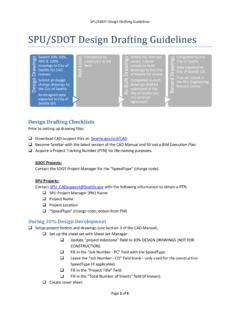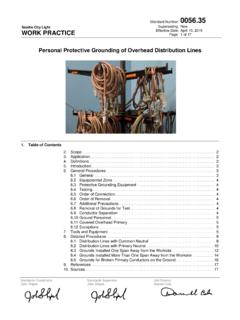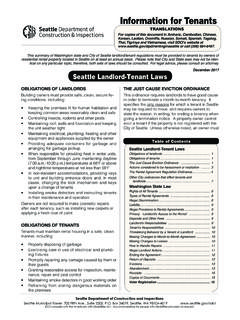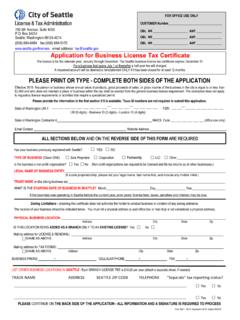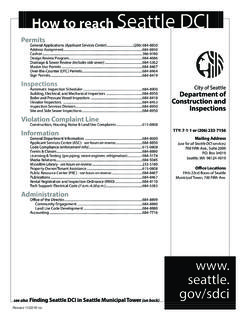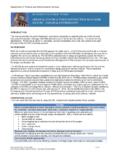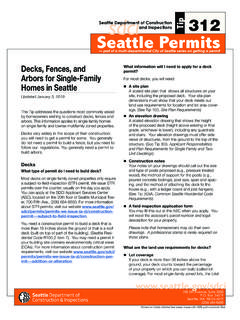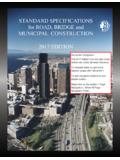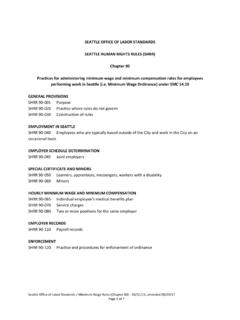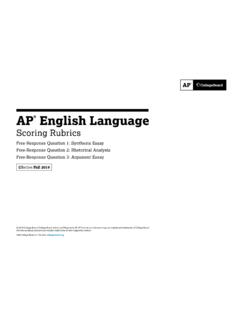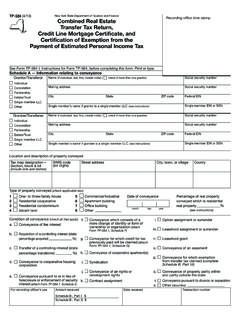Transcription of Seattle Department of Construction sdci and Inspections ...
1 5th Avenue, Suite 2000 Box 34019 Seattle , WA 98124-4019 (206) 684-8600 Seattle PermitsTipsdciSeattle Department of Constructionand Inspections part of a multi-departmental City of Seattle series on getting a permitPrinted on totally chlorine free paper made with 100% post-consumer fiber220 Lot Coverage, Height, Yard, and Garage Standards for Homes in Single Family ZonesUpdated April 24, 2012 Seattle has three zones in which single family homes are the predominant type of development: SF 9600, SF 7200 and SF 5000. The abbreviation SF stands for Single Family, and the numbers following the abbreviation indicates the minimum lot area generally needed to build a home in that Other than the differing lot size requirements, Land Use Code stan-dards that regulate the size and location of buildings are the same for all single-family zones. Development in Residential Small Lot (RSL) zones is subject to dif-ferent standards and is beyond the scope of this Tip.
2 New buildings and modifications to existing homes must conform to the lot coverage, height and yard standards described in the Land Use Code. Some examples of, and exceptions to, the requirements are presented here; however, you should also review the sections of the code that might apply to your project before preparing plans for a permit application. Code references are included in this Tip for addition to reading this pamphlet and the Land Use Code, you are welcome to discuss your project in per-son at the SDCI Applicant Services Center, located on the 20th floor of Seattle Municipal Tower, 700 Fifth Ave. Phone: (206) 684-8850. 1 Some existing lots are smaller than the minimum size, and the code allows creation of small lots under certain conditions - see Section of the Land Use Code, which is found in Title 23 of the Seattle Municipal Code (SMC). The section references used in this bulletin all begin with the chapter number (23), followed by the section number (.)
3 44) and the subsection (.020).LOT COVERAGEH omes (principal structures) and associated struc-tures (accessory structures) may cover 35 percent of the lot on lots 5,000 square feet or greater in area. On lots less than 5,000 square feet in area, these structures may cover 1,000 square feet plus 15 percent of the lot ( ). When calculating lot coverage, it is important to note that distinct portions or areas of a lot that have dimensions less than 10 feet will be excluded when calculating the overall lot area for the purpose of determining lot calculation is made on the footprint of all struc-tures on the entire lot. Balconies, bay windows, and architectural projections must be included in calcu-lating the footprint even though they do not actually touch the ground. However, the first 36 inches of eaves and gutters are exempted from this structures and permitted portions of principal structures may cover no more than 40 percent of the required rear yard ( ).
4 Lot Coverage Exceptions ( )If any of your lot lines abut a dedicated alley, you may add half the area of the alley to your total lot area, up to a maximum of 10 percent of your lot area, when computing lot structures are not counted in lot coverage. These include:n Pedestrian access bridges that are 5 feet wide or less (uncovered and unenclosed).n Barrier-free access ramps or other access for the disabled or elderly meeting Washington State Building Code Chapter 11. n Decks or parts of decks which are not over 36 inches above the existing Freestanding structures such as fences, bulkheads and freestanding walls, but not Underground structures or the underground por-tion of a Tip #220 Lot Coverage, Height, Yard & Garage Standards for Homes in Single Family Zones page 2 LEGAL DISCLAIMER: This Tip should not be used as a substitute for codes and regulations. The applicant is responsible for compliance with all code and rule requirements, whether or not described in this The first 36 inches of eaves and gutters projecting from principal or accessory Solar collectors meeting the provisions of and swimming pools meeting the provi-sions of Permit Application Requirements for Lot Coverage CalculationsAs described in Tip 103, Site Plan Requirements and Tip 103A, Site Plan Guidelines, you must calculate the lot coverage of existing and proposed development on your lot and show it on the site plan that you are required to submit with your application.
5 If you are not sure of the requirements, ask a Permit Specialist in the Applicant Services Center for help. HEIGHTThe base height of homes (principal structures) is 30 feet above average grade ( ). On lots 30 feet or less in width, the base height is limited to 25 feet (detailed measurement techniques are found in Chapter of the Land Use Code and in Director's Rule 9-2011).Pitched RoofsThe ridge of a pitched roof on a principal structure may extend up to 5 feet above the base height limit as long as the pitch of the roof is at least 4 to 12 (see Fig. A). No portion of a roof with only one sloping plane may extend beyond the base height limit (commonly known as "shed roof" design").Exemptions for Rooftop FeaturesUnder certain conditions, radio and television anten-nas and flagpoles are exempt from height rails and planters may extend no higher than the ridge of a pitched roof or four feet above a flat roof. Projections that accommodate windows, such as dormers, clerestories, skylights and greenhouses, may extend no higher than the ridge of a pitched roof or four feet above a flat roof provided that they are also limited to 30 percent of the area of the roof and meet separation and setback standards discussed in may extend four feet above the ridge of a pitched roof or above a flat roof.
6 Additional exemp-tions can be found in Compliance with Height LimitsAll projects must demonstrate compliance with applicable height limits for each structure on the site. Height limits may vary depending on the location on the property, and the use of the structure. The follow-ing information should be incorporated into the plan set for each structure proposed:Average Grade project plans need to document average grade and how it was determined. There are several options for calculating average grade, please refer to Director s Rule 9-2011 for a complete descrip-tion of the method for determining average grade. Average Grade for Projects in a Shoreline Zone - For projects located in a shoreline zone, please refer to Land Use Code Section for information about how to determine average grade for a Plan Documentation Applicants will choose a method for determining average grade. The site plan needs to reflect all midpoint elevation grade points, ex-terior wall lengths and the related calculations that are required to fully document the average grade elevation being used for height measurement purposes, based on Director s Rule 9-2011 or Land Use Code section A stamped topographic survey, prepared by a licensed surveyor, may be required if grade will be disturbed for Construction of the project and when any exterior wall of the new structure, in the area where grade is being disturbed, is within two feet of the al-lowed height limit as measured above existing grade.
7 SDCI Tip #220 Lot Coverage, Height, Yard & Garage Standards for Homes in Single Family Zones page 3 LEGAL DISCLAIMER: This Tip should not be used as a substitute for codes and regulations. The applicant is responsible for compliance with all code and rule requirements, whether or not described in this survey may also be required if the grade information provided by an applicant is not consistent with general site contours that are reflected in city GIS plan documentation should also identify the fol-lowing elevation points depending on roof design:n Roof ridge elevations or topmost elevation of a sloping roof with a shed or butterfly roof n Top of flat roof elevationsn Top of parapet or guardrail elevations n Top most elevation of any feature extending above the base height limit utilizing a height exemption, such as but not limited to roof planters, clerestories, Freestanding structures such as fences, bulk-heads, freestanding walls but not View Documentation Each building elevation drawing should incorporate the following elevation information.
8 N Existing grade elevations at the midpoints used in calculating the average The average grade elevation and a line depict-ing where this average grade lies in relation to the height of the Elevations for each floor Top plate elevations. For structures with a pitched roof, which qualifies for a height exception, the base height limit for the structure will be measured from the average grade elevation to the top plate elevation of the walls. All portions of roof above the height limit must qualify for the pitched roof excep-tions described in the code for the zone or in the measurements section of the Top of roof elevations. For structures that are not utilizing a pitched roof exception, the elevation of the highest element of the roof must be document-ed and must be within the base height limit for the structure plus exception for the roof. Figure Ba=72'D=60'B EI AEI 'Roof RidgeE1 134c=72'126top platefin grdEI 1321st FlrEI 106 Top PlateEI 126 RidgeEI 134 Avg Erd EI FlrEI 116EI 132 BasementEI 96' ' 'Sample Calculation, Figures B and CFormula 2: Average grade calculations, least rectangle(A x a) + (B x b) + (C x c) + (D x d) a + b + c +dFigure CExample: (106 x 72) + ( x 60) + ( x 72) + (103 x 60) 72 + 60 + 72 + 60(7632) + (6462) + ( ) + (6180) 264 Average grade = Tip #220 Lot Coverage, Height, Yard & Garage Standards for Homes in Single Family Zones page 4 LEGAL DISCLAIMER: This Tip should not be used as a substitute for codes and regulations.
9 The applicant is responsible for compliance with all code and rule requirements, whether or not described in this Top of roof features. For portions of structures that qualify for another type of height exception (such as, but not limited to, clerestories, solar col-lectors, open guardrails or planters), the elevation of the highest element of the feature must be docu-mented and must be within the allowable height limit plus exception for the Overall height dimension lines. Show dimension lines from the average grade line, to the top plate, to the top of roof and top of highest roof Exceptions to these height documentation require-ments may be allowed in consultation with the plan reviewer responsible for the zoning compliance and shall be based on the specifics of each project. YARDS (Land Use Code section )Required Front Yard: 20 feet or the average of the front yards of the single family residence on either side of your lot, whichever is Rear Yard: 25 feet, or 20 percent of lot depth (minimum of 10 feet) whichever is Side Yard: 5 feet.
10 10 feet for street facing side yard of a reversed corner Land Use Code requires that certain portions of your lot be set aside for front, rear and side yards. In general, no portion of your house may extend into these required yards. You may place accessory structures such as garages, sheds, decks, porches or arbors in these areas only if certain criteria are met. Exceptions from standard yard requirements are described in the following sections. Of course, you may provide more than the required minimum yard. Yards are measured from the property line in toward your structure. Property lines are not always obvious. Do not rely on physical features such as fences and sidewalks to indicate prop-erty lines. They may be on your neighbor s property or in the street basic yard requirements for single family zones are illustrated on Fig. requirements or exceptions may apply to a yard that borders an alley, is a corner lot, has an irregular shape, is a through lot (a lot with two street frontages opposite of each other), or is on a sloping lot that is greater than 35 percent.
